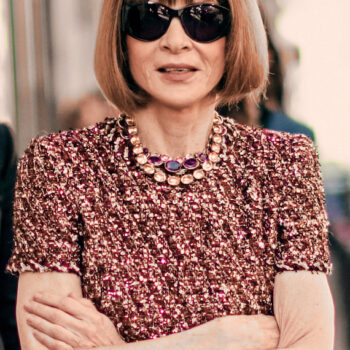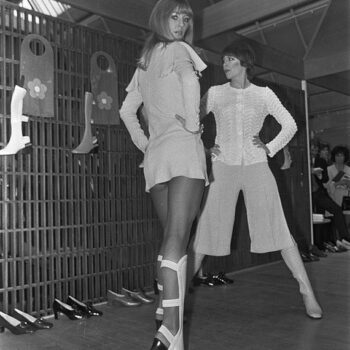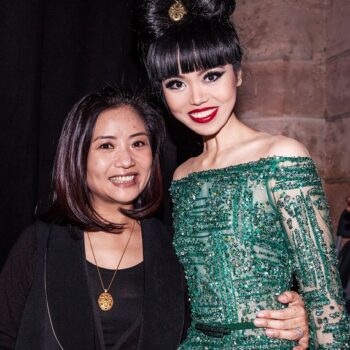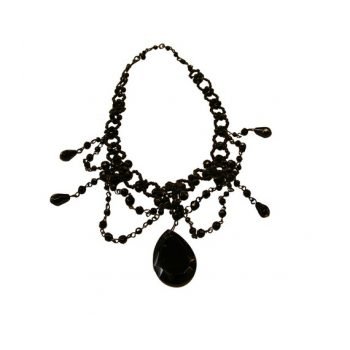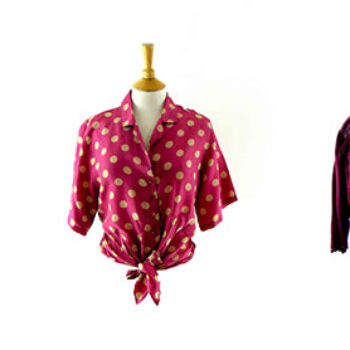The World of Anna Sui
August 23, 2017Anna Sui is one of a handful of American designers who defined the 1990s. Her own, personal magpie style was spot on in the era of grunge and thrift shop chic. But this retrospective, The World of Anna Sui at the Fashion and Textile Museum, shows there’s a lot more to her work than simple appropriation.
Anna Sui – Fashion Maverick
Sui was born in 1952 in Detroit, a white working class neighbourhood in America, to first generation Japanese American parents. She got into fashion at an early age, refusing to wear the same outfit twice as a child. When, as a teenager, she saw and article in a magazine about two American girls who had popped over to Paris and immediately hit the big time, starting a successful label more or less on the spot in a story just like a Hollywood movie, Sui immediately knew that was in her future, too.
She carefully noted that both women had trained at Parsons School of Design, and dedicated herself from then on to fulfilling the entry requirements to getting in – which she did. She later found out that the inspirational women in the magazine had not had the fairytale start it seemed, as one of them had contacts in the industry already. Anna Sui did not, and her background wasn’t conducive to high fashion, but nevertheless she persisted.
Inspiration of the designer
The first room in the exhibition covers this history. Anna Sui herself recounts it in voiceover, alongside her childhood dressing up exploits, and the inspirational magazine itself lies in a glass case. Dresses and outfits by Biba, Ossie Clark and Zandra Rhodes from the late 1960s and early 1970s are also shown as an example of the fashion inspirations of her nascent talent.
Atmospheric
From there, we’re into the main exhibition hall. As I’ve noted before, the Fashion and Textile Museum isn’t a big space, so shows always have to be tightly curated. Here, it has been re-decorated in quintessential Anna Sui style. If you are familiar with any of her stores, or even her makeup packaging, you’ll know the combination of glossy black, hippie purple, Chinese red and predilection for busy art deco patterns and 1960s themes like psychedelic posters, Tiffany style stained glass lampshades and cute dolly heads. All of this is deployed splendidly to really create the sense that you stepped into “Anna Sui World”. Music booms to further draw you in.
Anna Sui – A 1990s sensation
Anna Sui, as a brand, is still riding high today but her peak time was in the 1990s. They say in fashion that what goes around comes around, and Anna Sui exemplifies this – as today’s young designers have an affection for the 1990s clothes they saw around them growing up, so Sui is greatly influenced by the 1970s clothes of her childhood. What’s interesting about this is that in the 1970s, Barbara Hulanicki of Biba and Yves Saint Laurent were both heavily influenced by the 1930s, so this is very visibly 1990s via 1970s via 1930s.
Dress up in the vintage store
Only 20 years later she was recycling these styles, along with, as her catwalk collections multiplied, borrowings from many other time periods. Sui states that she loves researching different fashion periods and styles.
Here at the museum, the mannequins stand in groups characterised by her “archetypes” – “Victorian”, “Punk”, “Schoolgirl”, “Androgyny”, “Retro”, “Rockstar”, “Hippie”, “Surfer”, “Grunge”, “Nomad”, “Fairytale”, “Americana” and “Grunge” – which to me are a little bit loose – the “Victorian” section looks rather 1930s, and who knows what’s “Schoolgirl” about a short grey chiffon dress with a short, pearlised knitted bolero. And what does “Retro” mean exactly in this context? Seems like they put all the 1940ish styles in here. But, no matter. Each core theme bleeds into one another anyway – think dress up in the vintage store, pulling from all eras and styles.
Anna Sui – Meticulously designed
But look closer and the garments aren’t literal rip offs of existing garments. Each bears Anna Sui’s personal themes and preferences.She likes layering, and she likes that 90s staple of short, babydoll length skirts – though not all of her skirts are that length. But what really makes the pieces stand out is the attention to detail, to prints, colours, buttons and trims.
What initially looks like what could be a practice swoop through a vintage treasure trove, put together by a stylish eye is actually revealed to be so much more painstaking than that. The Chinese red of a traditional carved pendant is used as the exact colour of a print on the red, cream and black trousers it accessorises; the print itself is taken from the embroidered trim of the black velvet jacket that goes with the ensemble. To finish, exquisite red satin shoes, like a high heeled sneaker but so much less tacky than that description would suggest.
Similarly, the print of a skirt is echoed in smaller scale on a pair of tights, and a wave pattern, used as a trim on another skirt, is again echoed in the tights. Tights are quite a big consideration in Anna Sui ’s designs.
Curatorial viewpoint
This kind of loose grouping is an interesting curatorial decision – as far as I can see, and I’m not positive, the mannequins aren’t grouped by year or collection. The reason I’m not sure about this is that there were no info panels next to each outfit or even on the wall nearby; instead, small booklets had been printed and security cabled to the stands.
At first glance these nicely produced books looked like they were scattered around as a teaser for some little memento you could buy in the gift store. When I realised that they were different for each section, though bearing the same cover and in lieu of info panels I found them rather awkward to use – the cable too short to handle the book while standing and the information contained inside, being text only and no accompanying photo, rather hard to match to each outfit.
Anna Sui’s team
Moving upstairs, there is a generous acknowledgement of Anna Sui ’s collaborators – the legendary make up artists Francois Nars and Pat McGrath, the jewellers Ericson Beaumon who create her accessories, the milliner James Coviello, photographer Stephen Meisel and hairstylist Garren. Lacquered cabinets show off tempting shoes and part of Sui’s makeup range.
Then we move on to mood boards, which were interesting, and the large, always chilly room at the end that showcased a video about Sui and examples of her fashion show invites.
Small caveats aside, this is a fascinating, fun show, that definitely educates you about a talented designer.
The World of Anna Sui is on at the Fashion and Textile Museum until October 1st.





